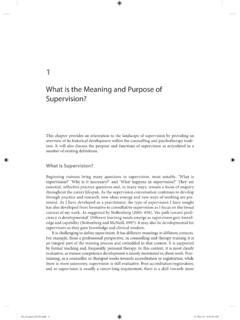Transcription of Eudaimonic and Hedonic Well- Being
1 Carol D. Ryff, Jennifer Morozink Boylan, and Julie A. Kirsch, Eudaimonic and Hedonic Well- Being In: Measuring Well- Being . Edited by: Matthew T. Lee, Laura D. Kubzansky, and Tyler J. VanderWeele, Oxford University Press (2021). Oxford University Press. DOI: oso/ and Hedonic Well- BeingAn Integrative Perspective with Linkages to Sociodemographic Factors and HealthCarol D. Ryff, Jennifer Morozink Boylan, and Julie A. KirschAbstractThis chapter provides an overview of two prominent approaches to well- Being , the Hedonic and the Eudaimonic , both with roots traceable to the ancient Greeks. We first examine the distant history of each approach and then describe scientific endeavors seeking to translate the ideas to empirical assessment tools.
2 We then review how these two varieties of well- Being are distributed in the general population by attending to their associations with major demographic factors (age, socioeconomic status, gender, race) as well as the interplay (intersectionality) of such factors. Such information contextualizes what is known about who reports they are or are not experiencing various aspects of well- Being . The third sec-tion then examines how Hedonic and Eudaimonic well- Being are linked with multiple indicators of health (self- reported, morbidity, mortality, bi-ological systems). Although extensive research exists, there is a paucity of studies that have jointly examined both types of well- Being . The fourth section draws attention to changing historical conditions and what that means for the future study of well- Being and prominent varieties of well- Being , namely Hedonic and Eudaimonic well- Being , are the focus of this chapter.
3 Because extensive research over multiple decades has grown up around these two approaches, the objective is to distill what has been learned from prior studies in hopes of building a cumulative science of well- Being . We begin by reviewing the conceptual meanings and philosophical origins of hedonia and eudaimonia, followed Eudaimonic and Hedonic Well- Being 93by consideration of how the ideas were translated to scientific tools needed to assess the two broad approaches to well- Being . Not included in our cov-erage are more recent perspectives on well- Being ( , Goodman, Disabato, Kashdan et al., 2017; Su, Tay, & Diener, 2014; VanderWeele, 2017), given that limited research has been assembled on these relative to Hedonic and Eudaimonic definitional beginnings, the second section summarizes ev-idence on how Hedonic and Eudaimonic well- Being are distributed in the general population.
4 Specifically, we examine how they are associated with key sociodemographic variables (age, socioeconomic status [SES], gender, race). Although frequently included in analytic models as covariates, these mostly assigned variables warrant careful consideration in their own right because they afford critical windows into life contexts. That is, they situate human lives within broader social structural realities that are critical for un-derstanding experiences of well- Being . We also draw attention to the inter-play (intersectionality) of these defining attributes and call for further work of this nature in future studies. Again, we note that our look at correlates of Hedonic and Eudaimonic well- Being is not exhaustive.
5 For example, we do not include personality or relational correlates ( , Marks & Lambert, 1998; Pavot, Diener, & Fujita, 1990; Schmutte & Ryff, 1997), nor do we con-sider how religiosity and spirituality matter for well- Being and health ( , Greenfield, Vaillant, & Marks, 2009; Koenig, King, & Carson, 2012), even though several chapters in this volume (Chapters 10, 11, and 16, all in this volume) address religion and a selective focus on Hedonic and Eudaimonic well- Being , the third section then examines how they are linked with multiple indicators of health. Our coverage includes self- reported health, morbidity, mortality, and biological systems. Although only limited studies have included meas-ures of both types of well- Being , those that have underscore the independent effects of each.
6 Tracking these associations longitudinally, as is done in the chapter by Trudel- Fitzgerald, Kubzansky, and VanderWeele (Chapter 5, in this volume) linking well- Being to mortality, is a key future economic, social, and political change has been prominent in recent times, a fourth section then calls for greater attention to historical dynamics in future research on well- Being . We consider how heightened job, financial, and housing hardships, which unfolded during the Great Recession, matter for people s subjective views about their lives and for their health. Building on evidence of increased experiences of despair, particularly 94 Empirical Research on Well- Being Measurementamong disadvantaged segments of society, we call for future inquiries that address growing problems of Is Psychological Well- Being ?
7 There are multiple ways to conceptualize and measure what it is to be well. Interestingly, the definitional challenges have distant philosophical roots. The ancient Greeks, for example, were interested in fundamental questions about how to live effectively, what constitutes a good life. Aristippus (435 356 bce) taught that the goal of life is to experience the maximum amount of pleasure and that happiness consists of the totality of one s Hedonic moments (Laertius, 1925). He took pride in extracting enjoyment from many circumstances and, relatedly, in controlling both adversity and prosperity. Epicurus (341 270 bce), in turn, founded the school of philosophy known as epicureanism, which sought to attain a happy, tranquil life, one characterized by peace and freedom from fear and pain.
8 Living a self- sufficient life surrounded by friends was also part of his view (Barnes, 1986). In notable contrast, Aristotle s (384 322 bce) Nichomachean Ethics, written in 350 bce, stated that the highest of all human goods achievable by human action was eudaimonia, which he defined as ac-tivity of the soul in accord with virtue. The highest virtue for Aristotle was thus a kind of personal excellence; that is, achieving the best that is within contrasting conceptions of well- lived lives continue to have reso-nance in our own era. Ryan and Deci s (2001) integrative review of the field of well- Being , in fact, organized it in terms of two broad traditions: one dealing with happiness ( Hedonic well- Being ) and the other dealing with human po-tential ( Eudaimonic well- Being ).
9 Both formulations have been fundamental in current efforts to understand the nature of human well- Being (Huta & Waterman, 2014; Vitters , 2013; Waterman, 1993). Although other psycho-logical characteristics ( , optimism, sense of control, conscientiousness) constitute valued aspects of positive functioning, as noted in our introduction, coverage in this chapter is restricted to Hedonic and Eudaimonic well- Hedonic ApproachKahneman, Diener, and Schwarz (1999) defined Hedonic psychology as the study of what makes experiences in life pleasant and unpleasant, thus aligning Eudaimonic and Hedonic Well- Being 95themselves with certain conceptions from the ancient Greeks. Nonetheless, it is important to underscore that multiple additional terms (and related as-sessment items) subjective well- Being , life satisfaction, happiness, positive and negative affect are exemplars of the Hedonic approach.
10 In addition, it is useful to recognize that many indicators in this arena had little, if any, conceptual or philosophical foundation. For example, in the middle of the past century, interest in subjective well- Being emerged not in an effort to illu-minate meanings of Hedonic psychology, but rather in pursuit of ideas about quality of life that could serve as a window on social change (Land, 1975). The argument at the time (Andrews & Withey, 1976; Campbell, Converse, & Rodgers (1976) was that even though people live in objectively defined envir-onments ( , income), it is their subjective experience that offers uniquely relevant information on quality of from that era (Bradburn, 1969; Cantril, 1965; Gurin, Veroff, & Feld, 1960) considered life satisfaction and happiness to be key components of well- Being .)






